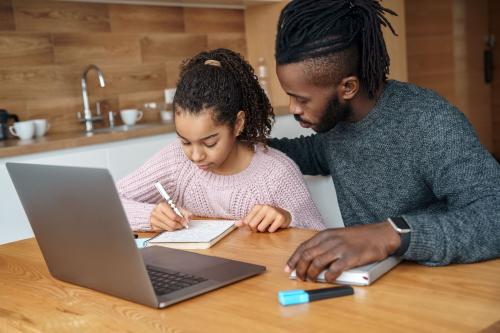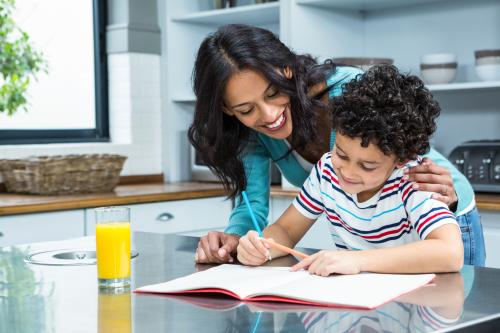As the omicron variant spreads across the world, families and schools are grappling with how to continue their children’s education. Tired of online learning and worried about safety, parents’ and teachers’ patience is being heavily tested. In many communities around the world, COVID-19 has already led to increasingly divisive family-school relationships. In politically polarized communities in the U.S., some schools are facing hostile parents on both sides of the masking debate, turning school board meetings into shouting matches. In Italy and the United Kingdom, angered parents protest school closures and calls for school children to get vaccinated.
Division, anger, and mistrust between families and schools are not good for anyone, but they especially do not bode well for students. Rigorous evidence has shown that when families and schools have strong relationships, children win: They are more likely to stay in school, graduate, and do well academically as well as socially. Trusting relationships between families and schools also help schools navigate change, acting as a “lubricant” to organizational reforms. Karen Mapp, an expert on family-school collaboration at Harvard University explains, “I’m seeing quite a few school districts realizing that family engagement—and I’m describing that as real, respectful partnerships between families and school staff—is as an absolutely essential ingredient to not only student improvement, but also school improvement.”
Rigorous evidence has shown that when families and schools have strong relationships, children win: They are more likely to stay in school, graduate, and do well academically as well as socially.
For the past three years, I have been studying family-school collaboration. Together with my colleagues and partners, we have surveyed nearly 25,000 parents and 6,000 teachers in 10 countries and delved into the “why” and “how” of building strong relationships and effective collaboration. This collaboration resulted in the Center for Universal Education’s (CUE) hands-on resource “Collaborating to improve and transform education systems: A playbook for family-school engagement,” which is designed to help education leaders—and families themselves—find a path toward a new, more constructive way of working together. It also offers insight on why frustration in some communities between families and schools has bubbled over and how to fix it.
Below are five key insights from the playbook.
1. Lean into family-school collaboration, not hope things “return to normal”
Out of the pandemic and remote learning experience, families from Colombia to the United States are emerging with increased expectations of deeper engagement with their schools. Likewise, teachers are interested in finding new ways of working with families. In our survey of teachers, in 8 out of the 9 jurisdictions, teachers said they plan to engage differently with their students’ parents and caregivers. Leaning into this interest for deeper and different kinds of engagement can help schools engage a wider diversity of family voices and perspectives, not just the most vocal. Ignoring families’ voices will not make them go away and will likely just foster frustration and resentment.
2. Don’t blame teachers and school leaders, train them
Schools were not designed to deeply engage families in children’s education, and family-school engagement is an afterthought in most current education systems. In the first wave of school closures in 2020, the Organisation for Economic Co-operation and Development surveyed 59 countries when schools were beginning to reopen and found that only 1 in 4 consulted families on reopening plans. Education leaders, teachers, and school personnel rarely get any in-depth training and professional development on the specific skills and approaches needed to work with families and community members. In the United States, less than half of the 50 states require learning about effective family and community engagement strategies to become a school leader, and less than a third of states require it to become a teacher. In communities from the U.S. to Europe to Africa, teachers report engaging with families to be one of the most difficult parts of their job. “When parents disregard teachers, it is hard to stand before students and play an active role as an elder,” says one teacher in Botswana. Investing in the training and development of our schools’ professionals is essential if we are to use the COVID-19 moment to transform how families and schools work together. Anger and blame will only make things worse, not better.
3. Bring schools to families, not just families to schools
The primary way most schools connect with families is by bringing them to a meeting at the school. Whether it is a back-to-school night or a parent-teacher meeting, schools are likely to only get a subsection of families attending. Caregivers with multiple jobs or multiple children can find it difficult to fit these meetings into their busy schedules. Families who do not speak the language in which the meetings are held—or who have had limited or bad experiences—often feel unwelcome in schools. However, as education jurisdiction leaders, school heads, and teachers faced school closures during COVID-19, many started using creative strategies for connecting with families and found a surge in participation. For example, when the government of Himachal Pradesh, a state of almost 7 million people in India, pivoted from asking parents to come to schools for meetings to finding multiple ways for schools to come to parents—through text messages, WhatsApp groups, and Facebook posts—engagement levels jumped from 20 percent to 80 percent in two months.
My colleagues and I reviewed over 500 family engagement strategies, including emerging approaches during the pandemic, and found a diverse array of useful approaches for schools to connect with families at home. Ultimately, around the world families want to support their children’s education and it is often schools meeting them where they are to foster the connection.
4. Build trust by engaging parents, not just involving them
For family-school collaboration to be effective, it is important to build trusting relationships among parents and caregivers and school personnel. Education leaders can develop relational trust through a range of strategies, but perhaps the first approach is to do less family involvement and more family engagement. Family involvement is often characterized by schools “leading with their mouths” and telling families when and how to connect and participate, whereas family engagement is characterized by schools “leading with their ears” to hear families’ concerns and how they would like to engage. Schools can usefully incorporate both approaches. Sometimes “typical” family involvement strategies like sending newsletters and hosting back-to-school nights can be helpful. Engagement approaches ranging from empathy conversations to home visits to digital parent-school chat groups are essential for building open communication, trust, and true partnership.
One of our Family Engagement in Education Network members, Kidsburgh, has taken our playbook and created workshop materials for schools, including this helpful summary of involvement versus engagement (Figure 1). Most jurisdictions rely heavily on involvement and less on engagement strategies.
Figure 1.

5. Make time to have an intentional conversation about what makes for a good education
For education leaders wondering where to start, one good place is to make time to have a conversation with the school community—families, teachers, school staff, and students—about what makes for a good quality education. In our research, we found parents and teachers often had different visions about the most important purpose of school and the most important types of elements to make it “high quality.” Rarely is there time in the day-to-day schedule to discuss what families and teachers hope and desire for their children and align around a common vision. Instead, interactions are heavily focused on academic progress, behavior, and other measures schools track. The Conversation Starter Tools in our playbook provide education and community leaders a guide to beginning this dialogue between families and schools.
Family-school engagement is emerging as an essential part of education system improvement and transformation, and much more information about how it is positively affecting children’s education is available in CUE’s new playbook. The education landscape continues to change every day and to successfully navigate this change, families and schools must work together in the effort to provide all children a high-quality, 21st-century education.
-
Acknowledgements and disclosures
The author would like to acknowledge the research assistance of CUE Communications Coordinator David Bernstein.






Commentary
Top 5 insights for improving family-school collaboration during COVID and beyond
January 26, 2022